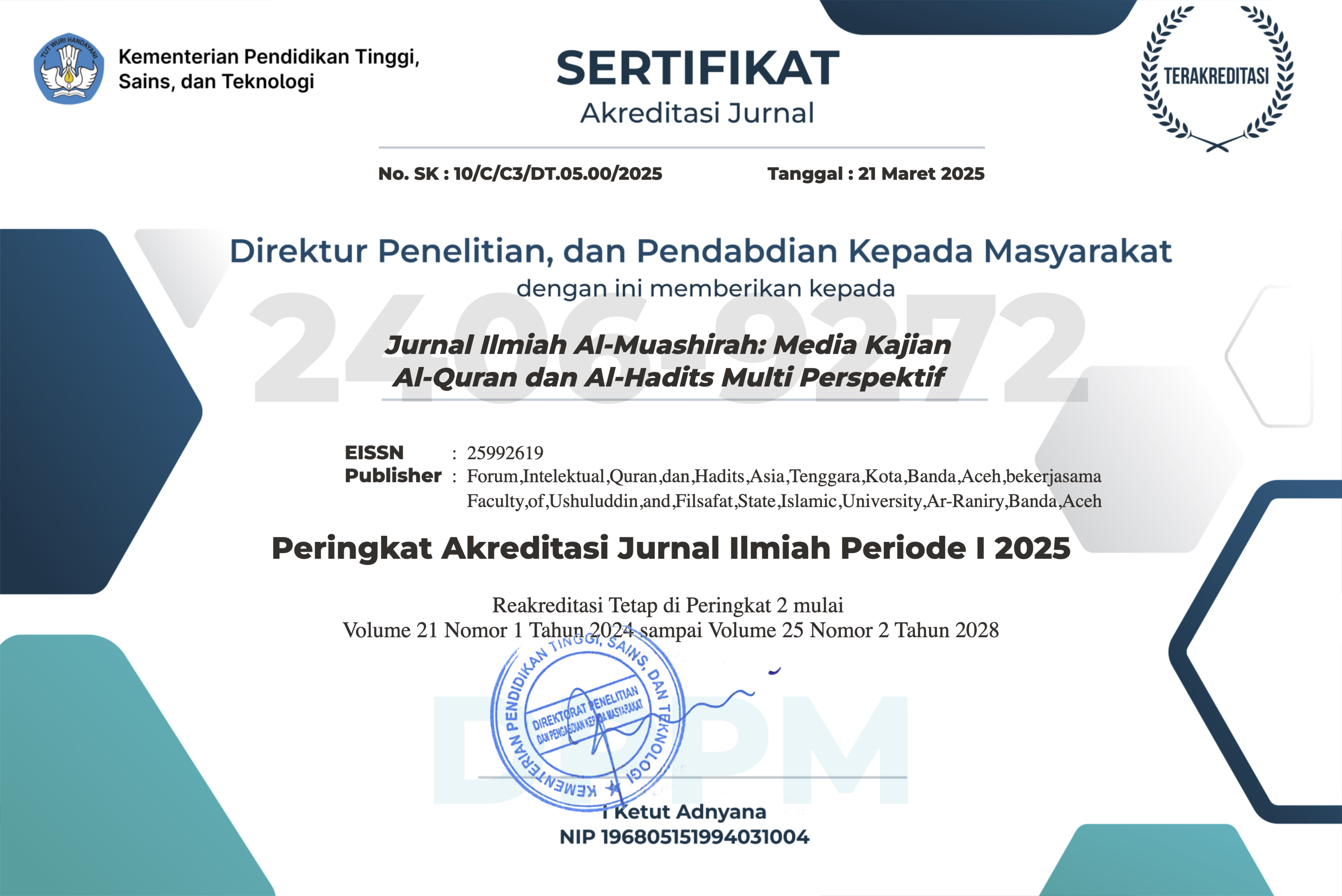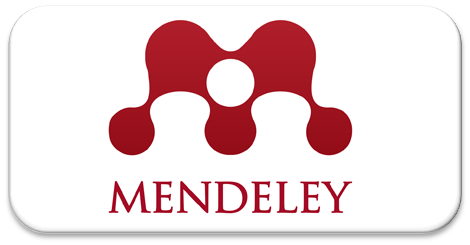THE SYMBOLIC MEANING OF SEURUMBEK RECITATION IN THE KEUNDURI BLANG TRADITION: STUDY OF LIVING QUR'AN IN PIDIE, ACEH, INDONESIA
DOI:
https://doi.org/10.22373/jim.v21i1.13521Keywords:
Keunduri blang, Seurumbek, Manuscript of Tgk. Chik Dipasi, Tradition, Living Quran.Abstract
The seurumbek, a mushaf manuscript by Tgk. Chik Dipasi, is highly revered and considered sacred by the community of Waido. The presence and recitation of seurumbek hold great significance in the keunduri blang tradition in Waido, setting it apart from other regions in Aceh. This research aims to explore the description of the implementation of seurumbek recitation and delve deeper into the symbolic meanings created within this tradition. The study employs a qualitative approach as part of field research, utilizing observation, interviews, and direct documentation techniques presented descriptively. The research is conducted in Waido, Pidie Regency, Aceh. The findings reveal that the seurumbek recitation occupies a central position in the keunduri blang tradition, evident from the special treatment it receives, both in storage and during the recitation process. Seurumbek recitation also creates complex symbols reflecting the relationship between humans and God, ancestors, others, and oneself. This practice serves as a mediator to draw closer to Allah, with symbolic actions such as shading, kissing, and showing respect for seurumbek reflecting reverence for Tgk. Chik Dipasi. Seurumbek recitation also symbolizes social relationships by strengthening Islamic brotherhood in the community. Additionally, it brings tranquility, patience, and sincerity as symbols of an individual's relationship with oneself.
Downloads
References
Al-Bukhari, Shahih Bukhari (Daar at-Taseel)
Anismar, Rukaiyah, and Abdullah Akhyar Nasution, ‘Pemaknaan Simbolik Pada Prosesi Kenduri Blang: Studi Kasus Gampong Ulee Gle Pidie Jaya’, Jurnal Sosiologi Agama Indonesia (JSAI), 2.1 (2021) <https://doi.org/10.22373/jsai.v2i1.1180>
Arifin, Muhammad, and Abdul Manan, ‘Cultural Traditions of Khanduri Blang in Reubee Village Aceh, Indonesia’, Jurnal Ilmiah Peuradeun, 6.3 (2018) <https://doi.org/10.26811/peuradeun.v6i3.243>
Asofa, Burhan, Metode Penelitian Hukum (Jakarta: Rineka Cipta, 2004)
Atabik, Ahmad, ‘Interaksionisme Simbolik Ritual Meron Di Indonesia Dan Relevansinya Dalam Al Quran’, FIKRAH, 8.1 (2020) <https://doi.org/10.21043/fikrah.v8i1.7216>
Carter, Michael J, and Celene Fuller, ‘Symbolic Interactionism’, Sociopedia.Isa, 2015, 1–17 <https://doi.org/10.1177/205684601561>
Connoly, Peter, Aneka Pendekatan Studi Agama, trans. by Imam Khoiri (Yogyakarta: LKiS, 2012)
Daud, Syamsuddin, Adat Meugoe (Banda Aceh: Indatu Bookstore, 2009)
Fauziah, Mira, ‘Principles Of Listening In The Quran And Their Development In Islamic Preaching: A Study Of Surah Al-Nahl/16:78’, JURNAL ILMIAH AL MU’ASHIRAH, 20.2 (2023), 361–68 <https://doi.org/http://dx.doi.org/10.22373/jim.v20i2.19452>
Fazal, Khairil, and Mawardi Mawardi, ‘Hubungan Simbiosis Masyarakat Aceh Besar Dengan Tradisi Hindu’, Abrahamic Religions: Jurnal Studi Agama-Agama, 1.1 (2021) <https://doi.org/10.22373/arj.v1i1.9482>
Hadi, Abdul, ‘The Internalization of Local Wisdom Value in Dayah Educational Institution’, Jurnal Ilmiah Peuradeun, 5.2 (2017) <https://doi.org/10.26811/peuradeun.v5i2.128>
Kriyantono, Rachmat, Teori-Teori Public Relations Perspektif Barat & Lokal, Cetakan Ke-2, 2017
Laksmi, Laksmi, ‘Teori Interaksionisme Simbolik Dalam Kajian Ilmu Perpustakaan Dan Informasi’, Pustabiblia: Journal of Library and Information Science, 1.2 (2018) <https://doi.org/10.18326/pustabiblia.v1i2.121-138>
Manan, Abdul, Cut Intan Salasiyah, Syukri Rizki, and Chairunnisak Chairunnisak, ‘Paddy Cultivation Rituals in South Acèh, Indonesia: An Ethnographic Study in West Labuhan Haji’, Cogent Social Sciences, 8.1 (2022) <https://doi.org/10.1080/23311886.2022.2094075>
Masruraini, Bahaking Rama, and Muhammad Rusydi Rasyid, ‘Perkembangan Pendidikan Islam Pada Masa Awal Hingga Lahirnya Kerajaan Islam Di Aceh: Lembaga Dan Tokohnya’, Jurnal Ilmu Pendidikan Dan Kearifan Lokal (JIPKL), 2.4 (2022)
Medri, L.K Ara, Ensiklopedi Aceh, Adat Hikayat Dan Sastra (Banda Aceh, 2008)
Mugni, Abdul, ‘Ritual Khanduri Blang: Agama Dan Adat’, Jurnal Al-Ijtimaiyyah, 4.1 (2018) <https://doi.org/10.22373/al-ijtimaiyyah.v4i1.4777>
Muhammaddin, M., ‘Kebutuhan Manusia Terhadap Agama’, Jurnal Ilmu Agama UIN Raden Fatah, 14.1 (2013)
Musbikin, Imam, Mutiara Al-Qur’an: Khazanah Ilmu Tafsir Dan Al-Qur’an (Madiun, 2014)
Nurazizah, Nurazizah, ‘Proses Islamisasi Dalam Ritual Khanduri Blang Di Gampong Dayah Leubue Kecamatan Ulim Kabupaten Pidie Jaya’, SEMAR : Jurnal Sosial Dan Pengabdian Masyarakat, 1.02 (2023), 79–88 <https://doi.org/10.59966/semar.v1i02.443>
Nurdin, Abidin, Fajri M. Kasim, Muhammad Rizwan, and Mahmuddin Daud, ‘The Implementation of Meunasah-Based Sharia in Aceh: A Social Capital and Islamic Law Perspective’, Samarah, 5.2 (2021) <https://doi.org/10.22373/sjhk.v5i2.10710>
Nurhadi, Zikri Fachrul, ‘Komunikasi Dalam Pendekatan Islam (Telaah Teoretis Tentang Kajian Komunikasi Dengan Allah Melalui Shalat Dan Membaca Al-Qur’an)’, Communication, 6.1 (2015) <https://doi.org/10.36080/comm.v6i1.7>
Rahimah, Rahimah, Hasanuddin Hasanuddin, and Djufri Djufri, ‘Kajian Etnobotani (Upacara Adat Suku Aceh Di Provinsi Aceh)’, BIOTIK: Jurnal Ilmiah Biologi Teknologi Dan Kependidikan, 6.1 (2019) <https://doi.org/10.22373/biotik.v6i1.4045>
Reiza Fitriana, Yenny, Rahma Qur’aeni, Nida Aprilia Putri, Bondan Dwi Rizkia, Istiqomah Nur Cahyani, and Nur Rofiq, ‘Hukum Islam Terhadap Kebudayaan Kenduri’, At-Tasyri’: Jurnal Hukum Dan Ekonomi Syariah, 4.2 (2023) <https://doi.org/10.55380/tasyri.v4i2.413>
Rohmah, Ahtim Miladya, and Anwar Mujahidin, ‘Makna Simbolik Tradisi Pembacaan Yāsīn Faḍīlah: Studi Living Qur’an Di Desa Jono Kecamatan Tawangharjo Kabupaten Grobogan’, QOF, 6.2 (2022) <https://doi.org/10.30762/qof.v6i2.72>
Salamone, Frank A, Encyclopedia of Religious Rites, Rituals, and Festivals (New York, 2004)
Soeprapto, Riyadi, Interaksionisme Simbolik Perspektif Sosiologi Modern (Yogyakarta: Pustaka Pelajar, 2002)
Syamsudin, Sahiron, ‘Metodologi Penelitian Living Qur’an Dan Hadis’, TH-Press, 2007
Usman, Ibrahim, Kemukiman Tungoe Dan Sekitarnya Zona Civilazation, Historis-Culture of Teungku Chik Di Pasi in Waido (Langsa: Unsam, 2014)
Usman, Usman, and Hanafiah Hanafiah, ‘Peranan Teungku Chik Di Waido Ulama Ahli Meugoe’, Seuneubok Lada: Jurnal Ilmu-Ilmu Sejarah, Sosial, Budaya Dan Kependidiikan, 6.1 (2019), 1–10 <https://ejurnalunsam.id/index.php/jsnbl/article/view/1189>
Wana, Hagie, ‘Berkomunikasi Menggunakan Simbol Dalam Islam’ <https://www.nu.or.id/opini/berkomunikasi-menggunakan-simbol-dalam-islam-ZsfXE> [accessed 14 November 2023]
West, Richard, and Lynn H. Turner, Pengantar Teori Komunikasi Analisis Dan Aplikasi, Journal of Chemical Information and Modeling, 2017, liii
Wirawan, Ida Bagus, Teori-Teori Sosial Dalam Tiga Paradigma : (Fakta Sosial, Definisi Sosial, Dan Perilaku Sosial) (Jakarta: Kencana Prena Media, 2012)
Interview with Tgk Asnawi on March 5th 2023
Interview with Ali Basyah on March 5th 2023
Interview with Tgk Asnawi on January 5th 2023
Interview with Tgk Faisal on March 5th 2023
Downloads
Published
Issue
Section
License
Authors who publish in Jurnal Ilmiah Al-Mu'ashirah agree to the following terms:
- Authors retain copyright and grant the journal right of first publication with the work simultaneously licensed under a Attribution-ShareAlike 4.0 International (CC BY-SA 4.0) License that allows others to share the work with an acknowledgment of the work's authorship and initial publication in this journal.
- Authors are able to enter into separate, additional contractual arrangements for the non-exclusive distribution of the journal's published version of the work (e.g., post it to an institutional repository or publish it in a book), with an acknowledgment of its initial publication in this journal.
- Authors are permitted and encouraged to post their work online (e.g., in institutional repositories or on their website) prior to and during the submission process, as it can lead to productive exchanges, as well as earlier and greater citation of published work (See The Effect of Open Access).













